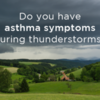In November 2016, a surprising event occurred in Melbourne, Australia. During an outbreak of thunderstorms, thousands of people had sudden asthma attacks around the same time. The strange weather event overwhelmed emergency facilities and personnel. Nine people died from the event. The phenomenon is called thunderstorm asthma.
Experts in Australia and Europe have been studying thunderstorm asthma for years. But we don’t hear much about it in the United States. Does that mean Americans won’t experience it?
The U.S. hasn’t had a widespread outbreak of thunderstorm asthma like Melbourne had, but many with asthma, especially allergic asthma, complain about their symptoms getting worse during thunderstorms.
What Is Thunderstorm Asthma?
When you have a thunderstorm on a day with high pollen and high humidity, you have a good situation for thunderstorm asthma. During a storm, rain hits pollen grains and breaks it up into smaller pieces. Then the wind from the thunderstorm picks them up and spreads them around. These smaller pieces can easily be inhaled into the lungs. Lightning might also break up the pollen.
“Severe storms will occur with more frequency and intensity because of increased temperatures due to climate change,” said Maureen George, PhD, RN, and spokesperson for the Asthma and Allergy Foundation of America. “This is concerning for the nearly 25 million Americans with asthma who will be put at increased risk of asthma attacks caused by storms.”
Can It Happen in the U.S.?
Researchers in Atlanta, Georgia, noticed a connection between asthma-related emergency room visits and thunderstorms. During their study, they found asthma visits were 3 percent higher after thunderstorms.1 They concluded there is some connection between thunderstorms and asthma.
Experts are still researching how much pollen it would take to for the U.S. to have an outbreak of thunderstorm asthma attacks. But even on a small scale, heavy rains can break up pollen, making it easier for you to breathe it in. Until we know more about thunderstorm asthma and why it happens, here are some ways you can lower your chances of having a weather-related asthma attack:
- See a board-certified allergist to help you determine your triggers. They can help you create an asthma management plan.
- Follow your doctor’s plan to keep your symptoms under control.
- If you have allergic asthma and pollen is one of your triggers, watch the weather, especially when humidity and pollen is high.
- Get support from others who have asthma. Asthma is easier to deal with if you have support from others after you leave the doctor’s office. AAFA has asthma and allergy online support groups you can join to talk to others with the same conditions.
Medical Review July 2017.
JOIN NOW
References
1. Grundstein, A., Sarnat, S. E., Klein, M., Shepherd, M., Naeher, L., Mote, T., & Tolbert, P. (2008). Thunderstorm-associated asthma in Atlanta, Georgia. Thorax, 63(7), 659–660. http://doi.org/10.1136/thx.2007.092882



Comments (0)